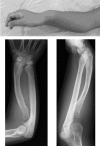Skeletal Deformity Associated with SHOX Deficiency
- PMID: 25110390
- PMCID: PMC4125598
- DOI: 10.1297/cpe.23.65
Skeletal Deformity Associated with SHOX Deficiency
Abstract
SHOX haploinsufficiency due to mutations in the coding exons or microdeletions involving the coding exons and/or the enhancer regions accounts for approximately 80% and 2-16% of genetic causes of Leri-Weill dyschondrosteosis and idiopathic short stature, respectively. The most characteristic feature in patients with SHOX deficiency is Madelung deformity, a cluster of anatomical changes in the wrist that can be attributed to premature epiphyseal fusion of the distal radius. Computed tomography of SHOX-deficient patients revealed a thin bone cortex and an enlarged total bone area at the diaphysis of the radius, while histopathological analyses showed a disrupted columnar arrangement of chondrocytes and an expanded hypertrophic layer of the growth plate. Recent studies have suggested that perturbed programmed cell death of hypertrophic chondrocytes may underlie the skeletal changes related to SHOX deficiency. Furthermore, the formation of an aberrant ligament tethering the lunate and radius has been implicated in the development of Madelung deformity. Blood estrogen levels and mutation types have been proposed as phenotypic determinants of SHOX deficiency, although other unknown factors may also affect clinical severity of this entity.
Keywords: Leri-Weill dyschondrosteosis; Madelung deformity; Vickers ligament; chondrocyte; short stature.
Figures



Similar articles
-
A Leri-Weill dyschondrosteosis patient confirmed by mutation analysis of SHOX gene.Ann Pediatr Endocrinol Metab. 2015 Sep;20(3):162-5. doi: 10.6065/apem.2015.20.3.162. Epub 2015 Sep 30. Ann Pediatr Endocrinol Metab. 2015. PMID: 26512353 Free PMC article.
-
Longitudinal Observation of a Patient with Leri-Weill Dyschondrosteosis and SHOX Haploinsufficiency.Clin Pediatr Endocrinol. 2005;14(1):11-6. doi: 10.1297/cpe.14.11. Epub 2005 Feb 14. Clin Pediatr Endocrinol. 2005. PMID: 24790304 Free PMC article.
-
Histopathological analysis of Leri-Weill dyschondrosteosis: disordered growth plate.Hand Surg. 2001 Jul;6(1):13-23. doi: 10.1142/s0218810401000424. Hand Surg. 2001. PMID: 11677662
-
SHOX Haploinsufficiency as a Cause of Syndromic and Nonsyndromic Short Stature.Mol Syndromol. 2016 Apr;7(1):3-11. doi: 10.1159/000444596. Epub 2016 Mar 15. Mol Syndromol. 2016. PMID: 27194967 Free PMC article. Review.
-
SHOX: growth, Léri-Weill and Turner syndromes.Trends Endocrinol Metab. 2000 Aug;11(6):227-30. doi: 10.1016/s1043-2760(00)00262-9. Trends Endocrinol Metab. 2000. PMID: 10878753 Review.
Cited by
-
A Leri-Weill dyschondrosteosis patient confirmed by mutation analysis of SHOX gene.Ann Pediatr Endocrinol Metab. 2015 Sep;20(3):162-5. doi: 10.6065/apem.2015.20.3.162. Epub 2015 Sep 30. Ann Pediatr Endocrinol Metab. 2015. PMID: 26512353 Free PMC article.
-
Acquired Madelung's deformity as a cause of recurrent monoarthritis in a young patient.Arch Rheumatol. 2024 Aug 26;39(3):467-470. doi: 10.46497/ArchRheumatol.2024.10548. eCollection 2024 Sep. Arch Rheumatol. 2024. PMID: 39507847 Free PMC article. No abstract available.
-
A Track Record on SHOX: From Basic Research to Complex Models and Therapy.Endocr Rev. 2016 Aug;37(4):417-48. doi: 10.1210/er.2016-1036. Epub 2016 Jun 29. Endocr Rev. 2016. PMID: 27355317 Free PMC article. Review.
-
A case of 45,X/47,XXX mosaic Turner syndrome with limb length discrepancy.Clin Pediatr Endocrinol. 2017;26(4):259-263. doi: 10.1297/cpe.26.259. Epub 2017 Sep 28. Clin Pediatr Endocrinol. 2017. PMID: 29026275 Free PMC article.
-
Identification of a limb enhancer that is removed by pathogenic deletions downstream of the SHOX gene.Sci Rep. 2018 Sep 24;8(1):14292. doi: 10.1038/s41598-018-32565-1. Sci Rep. 2018. PMID: 30250174 Free PMC article.
References
Publication types
LinkOut - more resources
Full Text Sources
Other Literature Sources
